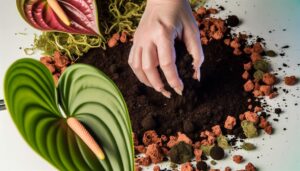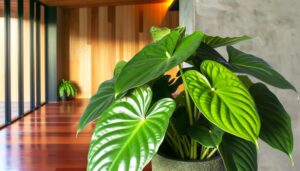10 Essential Tips for Anthurium Silver Blush Care
For Anthurium Silver Blush care, use a well-draining mix with orchid bark, perlite, and peat moss (pH 5.5-6.5). Water when the top inch of soil is dry, using filtered water.
Position in bright, indirect light, maintaining a temperature of 65-80°F. Keep humidity at 60-80% with a hygrometer and humidifier.
Prune damaged foliage above leaf nodes and repot every two years with fresh mix. Regularly check for pests like spider mites and treat with neem oil.
Provide a balanced, slow-release fertilizer to address nutrient deficiencies. For detailed care steps and tips, there’s more to uncover.
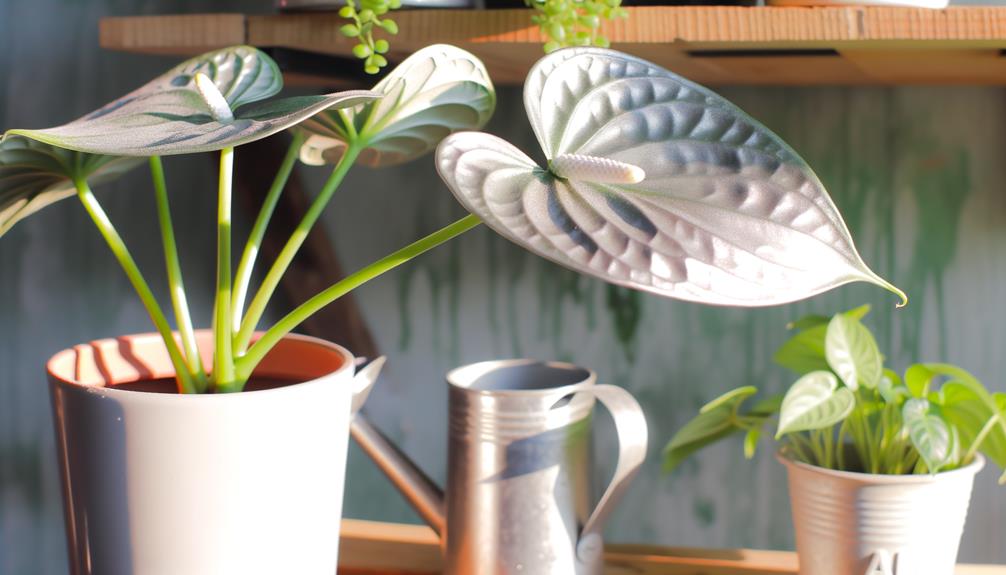
Key Takeaways
- Use a well-draining soil mix with orchid bark, perlite, and peat moss.
- Water when the top inch of soil is dry and avoid overwatering.
- Position in bright, indirect light to prevent leaf damage.
- Maintain humidity levels between 60-80% using a humidifier if needed.
- Regularly check for pests and use neem oil or insecticidal soap if necessary.
Choose the Right Soil

Choosing the appropriate soil for your Anthurium Silver Blush is crucial to ensure ideal drainage and root aeration. Select a well-draining mix that includes a combination of orchid bark, perlite, and peat moss.
This blend guarantees the roots receive adequate airflow while maintaining the correct level of moisture.
Aim for a pH level between 5.5 and 6.5 to support optimal nutrient absorption. Avoid dense, compact soils that may result in root rot. You can also add charcoal or coconut coir to improve the soil’s structure and drainage capabilities.
Repot your Anthurium every two years to renew the soil mix and prevent nutrient depletion. By selecting the appropriate soil, you’ll establish a flourishing environment for your Anthurium Silver Blush.
Optimal Watering Schedule
After establishing the right soil mix, it’s imperative to maintain a precise watering schedule to prevent overwatering and root rot in your Anthurium Silver Blush.
Water your plant when the top inch of soil feels dry to the touch. Insert your finger into the soil to gauge moisture levels accurately.
Use filtered or distilled water at room temperature to avoid mineral buildup. Water thoroughly until it drains out of the bottom of the pot, ensuring even moisture distribution. Avoid letting the plant sit in standing water as it can cause root rot.
During the growing season, typically spring and summer, you may need to water more frequently. In contrast, reduce watering during the dormant winter period.
Ideal Light Conditions
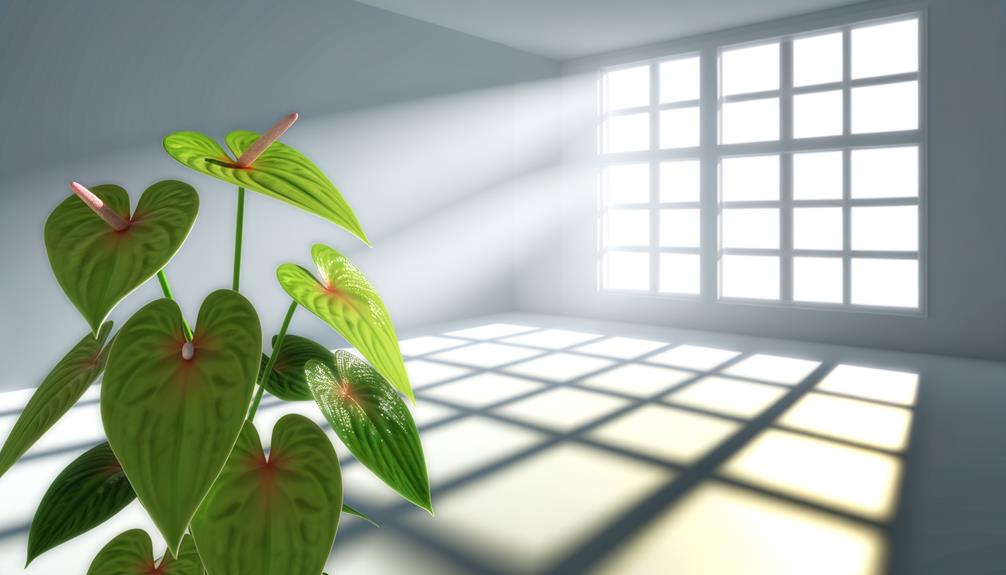
For best growth, position your Anthurium Silver Blush in bright, indirect light to mimic its natural understory habitat. Direct sunlight can scorch its delicate leaves, so avoid placing it in direct sun.
North or east-facing windows are ideal, or use sheer curtains to diffuse the light. Consistent light levels are essential; abrupt changes can stress the plant and stunt its growth. If natural light is insufficient, consider using grow lights.
| Light Source | Pros | Cons |
|---|---|---|
| Natural Indirect | Mimics natural habitat | Seasonal changes |
| North/East Windows | Gentle, consistent light | May need supplemental lighting |
| Grow Lights | Controlled environment | Electrical cost, setup required |
Humidity Requirements
Maintaining high humidity levels, ideally between 60-80%, is vital for your Anthurium Silver Blush to thrive and exhibit its striking foliage. Utilize a hygrometer to monitor ambient humidity precisely.
If levels fall below the best range, employ a humidifier to enhance moisture in the air. Position your plant near a humidity tray filled with water and pebbles, making sure the pot doesn’t sit directly in water to prevent root rot.
Grouping plants together can also create a microenvironment with higher humidity. Misting leaves regularly with distilled water can provide temporary relief, though it’s less effective long-term.
Ensure adequate ventilation to avoid fungal issues. Consistently maintaining these humidity levels will help your Anthurium Silver Blush flourish, displaying its beautiful, silver-veined leaves.
Temperature Preferences

To maximize growth, keep your Anthurium Silver Blush in a temperature range between 65-80°F, as it thrives in consistently warm conditions. Maintaining stable temperatures is essential for peak health and robustness.
Sudden drops or spikes can cause stress and impact growth negatively. Guarantee the plant is placed in a location with minimal temperature fluctuations.
Follow these key guidelines:
- Avoid Cold Drafts: Keep the plant away from windows or doors that may introduce chilly air.
- Provide Consistent Warmth: Utilize a space heater if necessary, especially during colder months.
- Monitor Temperature: Use a reliable thermometer to consistently check the ambient temperature around the plant.
These measures guarantee your Anthurium Silver Blush remains healthy and vibrant, ready to serve its decorative purpose.
Fertilizing Tips
To guarantee your Anthurium Silver Blush thrives, use a balanced, water-soluble fertilizer with a 20-20-20 NPK ratio. Apply the fertilizer at half-strength every 4-6 weeks during the growing season.
Avoid over-fertilizing as it can lead to nutrient burn and damage the plant’s roots.
Optimal Fertilizer Types
Selecting the right fertilizer for Anthurium Silver Blush involves choosing a balanced, water-soluble formula with an N-P-K ratio of 20-20-20 to promote healthy growth and vibrant foliage. This guarantees your plant receives a uniform supply of essential nutrients.
Here are three key steps to optimize fertilization:
- Dilution: Mix the fertilizer at half the recommended strength to prevent nutrient burn.
- Application: Apply the solution directly to the soil, avoiding contact with leaves to prevent damage.
- Timing: Fertilize during the growing season, typically from spring to early autumn, when the plant is most active.
Feeding Frequency Guidelines
Determine the best feeding frequency by fertilizing Anthurium Silver Blush every four to six weeks during its active growing period.
Use a balanced, water-soluble fertilizer with a ratio of 20-20-20. Dilute the fertilizer to half-strength to prevent nutrient burn.
Apply the solution directly to the soil, guaranteeing even distribution but avoiding leaf contact. During the dormant period, reduce feeding to every eight to ten weeks. Monitor the plant’s response closely, adjusting the frequency if yellowing or leaf drop occurs.
Always water the plant thoroughly before fertilizing to minimize root damage. By adhering to these feeding guidelines, you’ll guarantee your Anthurium Silver Blush thrives, displaying its characteristic silvery veined leaves to their fullest potential.
Pruning Techniques
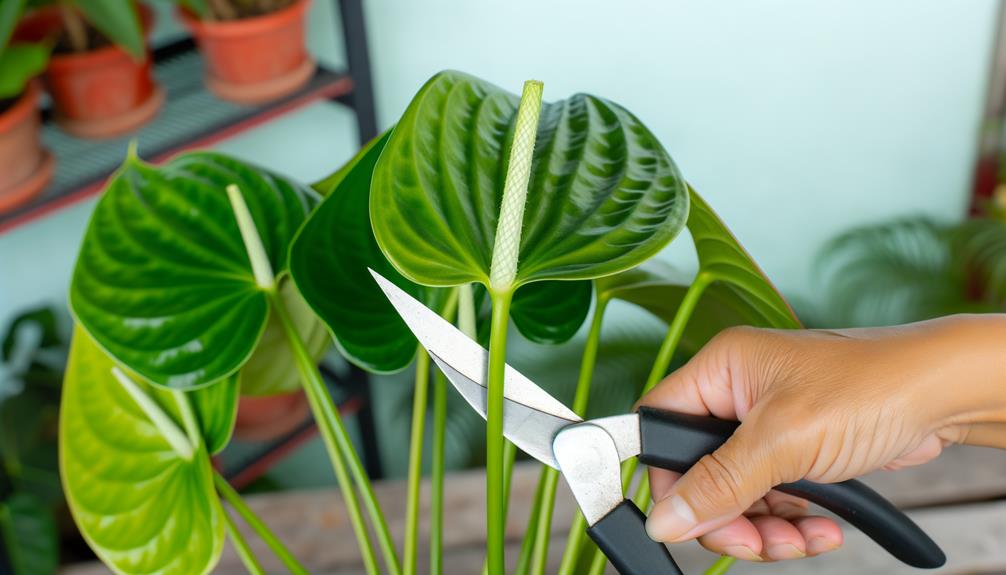
When pruning your Anthurium Silver Blush, start by removing dead or yellowing leaves to maintain plant health and prevent disease. Use sterilized pruning shears to make clean cuts, which will encourage new growth and improve overall vigor.
Additionally, shape the plant by trimming leggy stems, ensuring a more aesthetically pleasing form.
Removing Dead Leaves
To maintain the health and aesthetics of your Anthurium Silver Blush, you’ll need to regularly prune expired leaves using sterilized pruning shears.
Expired foliage can harbor pests and diseases, compromising your plant’s well-being. Here’s a precise method:
- Identify expired leaves: Look for yellowing, browning, or wilted leaves. These are no longer contributing to the plant’s overall well-being.
- Sterilize your shears: Use rubbing alcohol or a bleach solution to sterilize your pruning shears, preventing the spread of pathogens.
- Cut at the base: Carefully snip the expired leaves at their base, close to the main stem without damaging healthy tissue.
Encouraging New Growth
Pruning your Anthurium Silver Blush with strategic precision promotes robust new growth and maintains its lush appearance.
Focus on cutting back to a node, using sterilized pruning shears to prevent disease transmission. Aim to remove any leggy or weak stems, as this redirects energy to healthier parts.
Here’s a quick guide:
| Pruning Task | Best Tool | Timing |
|---|---|---|
| Remove dead leaves | Sterilized shears | Anytime |
| Trim leggy stems | Pruning scissors | Spring/Early Summer |
| Cut back to nodes | Clean shears | Spring |
Regular pruning also stimulates the plant’s natural growth hormones, resulting in a fuller, more vibrant specimen. Always make sure your tools are sharp to make clean cuts, minimizing stress on the plant.
Shaping the Plant
Shaping your Anthurium Silver Blush involves precise cuts that encourage balanced growth and an aesthetically pleasing form.
Use sterilized pruning shears to avoid infections. Focus on removing dead or yellowing leaves first, then prune leggy stems to maintain the plant’s compact structure.
Follow these steps:
- Identify: Locate any damaged or unhealthy foliage.
- Cut: Make clean cuts just above a leaf node or stem junction.
- Dispose: Remove all debris to prevent disease spread.
Repotting Guidelines
When repotting your Anthurium Silver Blush, select a well-draining potting mix to prevent root rot and support healthy growth.
Incorporate materials like orchid bark, perlite, and peat moss to guarantee adequate aeration and moisture retention.
Opt for a pot with drainage holes to facilitate water flow and avoid waterlogging. Gently remove the plant from its current container, taking care to untangle and trim any damaged roots.
Position the Anthurium in the new pot, filling around it with the prepared mix. Firmly press the soil without compacting it, ensuring the roots are well-supported. Water thoroughly after repotting, allowing excess water to drain.
Pest Control
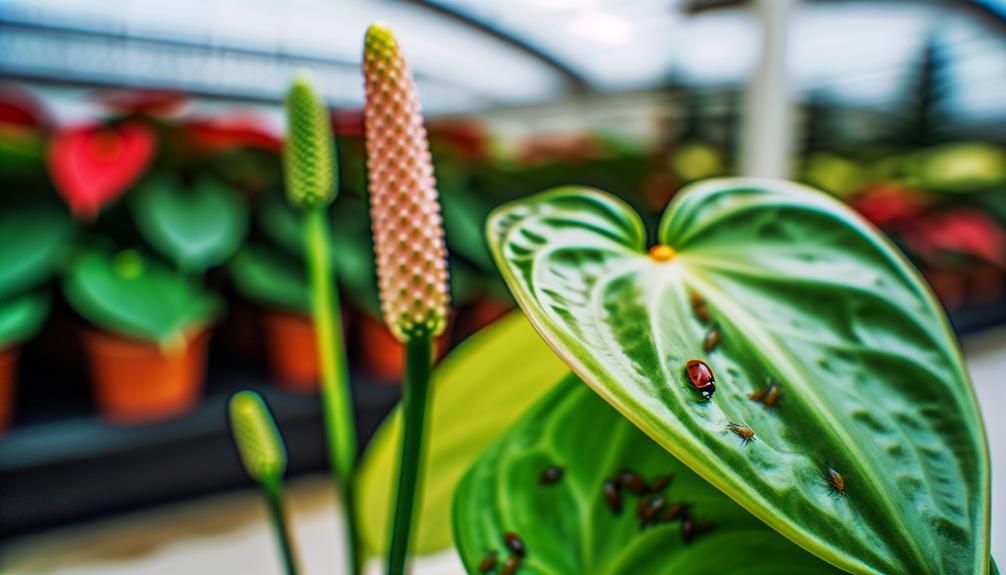
After repotting, it’s essential to monitor your Anthurium Silver Blush for common pests such as spider mites, aphids, and mealybugs, which can compromise the plant’s health.
Implement an integrated pest management approach to make sure your plant thrives:
- Inspection: Regularly check the undersides of leaves and stems for any signs of pests. Use a magnifying glass for a thorough examination.
- Isolation: If you detect pests, immediately isolate the affected plant to prevent spreading to others.
- Treatment: Utilize appropriate treatments like insecticidal soap, neem oil, or systemic insecticides. Follow the product instructions meticulously to avoid phytotoxicity.
Common Problems
Despite careful attention, your Anthurium Silver Blush may still encounter several common issues, such as leaf yellowing, root rot, and nutrient deficiencies.
Leaf yellowing often indicates overwatering or poor drainage. Make sure the potting mix is well-aerated, and adjust your watering schedule accordingly.
Root rot arises from prolonged waterlogged conditions. Check roots regularly, trim any affected areas, and repot using a well-draining mix.
Nutrient deficiencies show as stunted growth or pale leaves. Apply a balanced, slow-release fertilizer to address these concerns.
Additionally, monitor for signs of pests like spider mites and scale, which can worsen plant stress.
Conclusion
To sum up, nurturing a mesmerizing and flourishing Anthurium Silver Blush demands thoughtful deliberation and unwavering attention. Give importance to selecting suitable soil, watering accurately, and providing ideal light settings.
Sustain elevated humidity levels and consistent temperatures to aid its development. Routinely trim and replant to enhance its vitality. Diligently monitor for pests and promptly resolve any typical issues.
By carefully overseeing these elements, you’ll guarantee your Anthurium Silver Blush blooms into a striking, silver-patterned showpiece.

